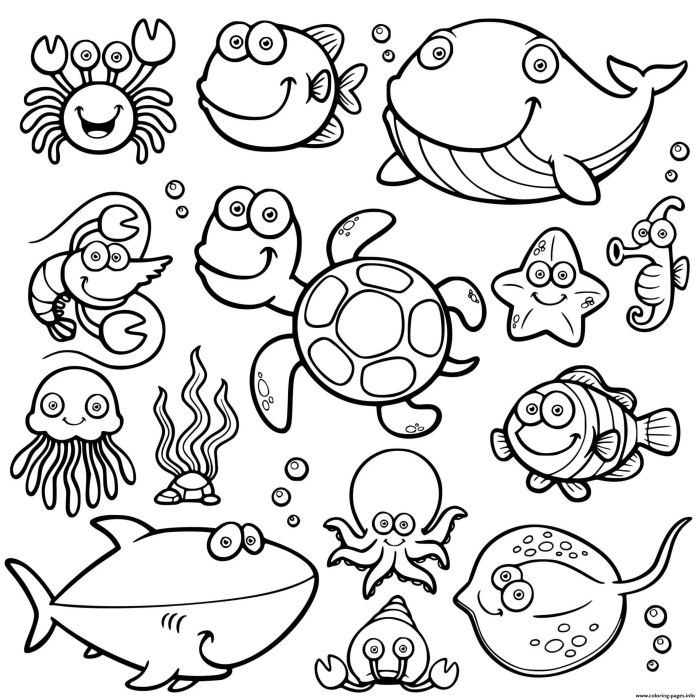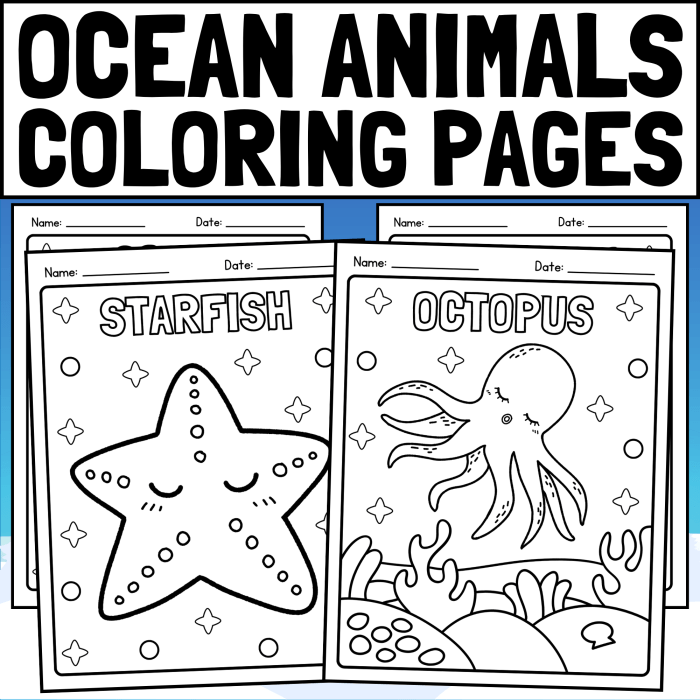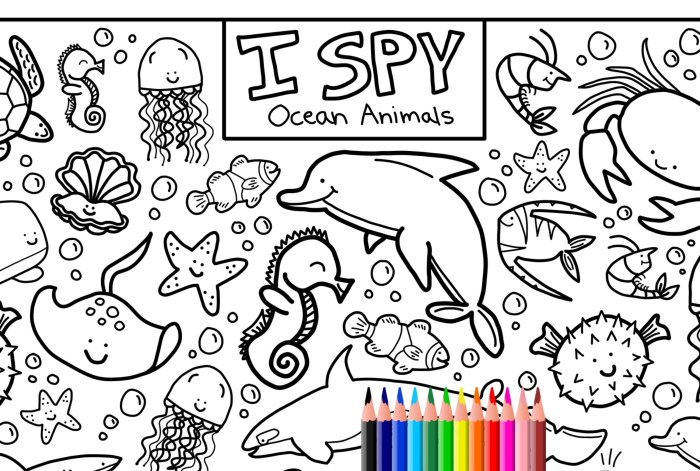Popularity and Trends of Ocean Animal Coloring Pages

Ocean animal coloring pages enjoy widespread popularity, appealing to a broad spectrum of ages and artistic skill levels. Their enduring appeal stems from the inherent beauty and fascinating diversity of marine life, offering a creative outlet for self-expression and a gateway to learning about the underwater world. This popularity is reflected in both online searches and the vast array of coloring books available commercially.
Most Popular Ocean Animals Featured in Coloring Pages
The most frequently featured ocean animals in coloring pages reflect a combination of familiarity, visual appeal, and cultural significance. Whales, particularly orcas and humpback whales with their dramatic size and expressive features, consistently rank high. Dolphins, known for their playful nature and intelligence, are also perennial favorites. Colorful fish, such as vibrant tropical reef fish like angelfish and clownfish (Nemo!), capture attention with their striking patterns and hues.
Sea turtles, with their gentle demeanor and ancient lineage, hold a special place, while sharks, despite their sometimes fearsome reputation, also appear frequently, often depicted in a more approachable, less menacing manner. Other popular choices include playful seals, graceful seahorses, and the majestic octopus.
Current Trends in Ocean Animal Coloring Page Designs
Current trends in ocean animal coloring page designs showcase a diverse range of styles and complexities. Intricate, detailed designs, featuring realistic depictions of ocean animals and their environments, are gaining popularity amongst older children and adults seeking a more challenging and rewarding coloring experience. These pages often incorporate fine lines and complex textures, inviting the use of various coloring techniques and mediums.
Conversely, simpler designs with bold Artikels and large areas of color remain popular for younger children, providing a more accessible and less frustrating coloring experience. Mandala-style designs incorporating ocean animal motifs are also becoming increasingly prevalent, appealing to those seeking a calming and meditative coloring activity. Furthermore, a trend towards incorporating elements of pop culture and fantasy into ocean animal coloring pages is noticeable, featuring animals with whimsical accessories or in fantastical settings.
Popularity of Ocean Animal Coloring Pages Across Age Groups
The popularity of ocean animal coloring pages varies across age groups, reflecting developmental stages and artistic preferences. Younger children (preschool to early elementary) gravitate towards simpler designs with bold Artikels and fewer details, focusing on large areas of color and basic shapes. Older children (late elementary to middle school) tend to prefer more complex designs with finer details, allowing for greater creative expression and skill development.
Adults often opt for highly detailed and intricate designs, seeking a relaxing and mindful activity that provides a sense of accomplishment upon completion. The themes and styles of the coloring pages also cater to these preferences; for instance, younger children might enjoy pages featuring cartoonish or simplified animals, while older children and adults might prefer realistic or stylized illustrations.
Frequency of Searches for Specific Ocean Animal Coloring Pages
While precise search data requires access to proprietary search engine analytics, general observations indicate that searches for “dolphin coloring pages” and “whale coloring pages” consistently rank high. Searches for specific species, such as “orca coloring page” or “humpback whale coloring page,” are also common. Similarly, searches incorporating specific styles, like “realistic shark coloring page” or “cute octopus coloring page,” indicate a demand for diverse artistic representations.
The seasonality of some searches is also noticeable, with searches for “sea turtle coloring pages” potentially peaking during summer months, reflecting increased awareness and interest in marine conservation. This diverse range of searches highlights the broad appeal and adaptability of ocean animal coloring pages across various interests and preferences.
Design Elements of Effective Coloring Pages: Ocean Animal Coloring Page

Creating captivating ocean animal coloring pages requires a thoughtful approach to design, ensuring visual appeal and an engaging coloring experience for diverse age groups. The success of a coloring page hinges on the careful selection of line art, color palettes, and the overall level of detail.
Visually appealing ocean animal coloring pages balance simplicity with intricate detail. Simple designs are ideal for younger children, while more complex illustrations cater to older children and adults. The line art should be clear, crisp, and easy to follow, avoiding overly thin or overly thick lines that might be difficult to color within. The overall composition should be well-balanced, with the main subject clearly defined and surrounded by complementary elements.
Consider incorporating subtle textures or patterns within the animal’s features to add depth and visual interest without overwhelming the design.
Color Palettes for Enhanced Coloring
The choice of color palette significantly influences the coloring experience. A limited palette, using 3-5 coordinating colors, can guide younger children and encourage experimentation with color harmony. For older children and adults, a wider range of colors, including nuanced shades and tints, allows for more creative expression and detailed shading. For ocean-themed pages, consider palettes inspired by the ocean itself: cool blues and greens for the water, vibrant corals and yellows for fish, and earthy browns and grays for the seabed.
Using a color guide with suggested color schemes alongside the coloring page can enhance the experience, especially for younger colorists.
Line Art Styles for Different Age Groups
Line art style directly impacts a coloring page’s suitability for different age groups. Younger children benefit from bolder, simpler lines and larger shapes, minimizing fine details that might frustrate them. Think of a cartoonish sea turtle with large, easily colorable flippers and shell segments. Older children and adults appreciate more intricate line work, including detailed textures, shading, and fine lines that create a sense of depth and realism.
An example would be a highly detailed octopus with individual suckers and complex skin texture. Adults might even enjoy a coloring page with a complex coral reef scene, requiring a higher level of precision and patience.
Example: A Detailed Coloring Page of a Sea Otter
Imagine a sea otter sprawled on its back, floating on calm, gently textured water. The otter’s fur is suggested through short, slightly curved lines, creating a soft, fluffy appearance. Its large, expressive eyes are clearly defined with dark pupils and highlights, bringing the animal to life. Its paws are meticulously detailed, showing individual claws and webbed toes. Seaweed gently wraps around the otter, adding a playful element to the design.
Kelp forest details in the background are suggested with thinner, more delicate lines, providing a context to the scene without overwhelming the main subject. The lines are thick enough to be easily colored within, but not so thick as to obscure the detail. The overall style is naturalistic but slightly stylized, appealing to a broad range of ages and skill levels.
The clean lines and interesting details, such as the individual hairs in the fur, provide a satisfying coloring experience for both beginners and experienced colorists.
Educational Value and Applications

Ocean animal coloring pages offer a surprisingly rich tapestry of educational benefits, extending far beyond simple artistic expression. They engage children’s creativity while subtly introducing them to the wonders of the marine world, fostering a deeper understanding of ocean life and its importance. These pages can serve as a springboard for learning, sparking curiosity and encouraging further exploration.Coloring pages featuring ocean animals provide a valuable tool for learning about marine biodiversity.
Children can visually identify different species, learning their names and distinguishing features through the act of coloring. This visual learning method is particularly effective for younger children who are still developing their reading and writing skills. The process of carefully coloring the details of each animal helps reinforce their memory and understanding of the species’ characteristics. Furthermore, the vibrant colors and intricate details of the ocean animals can ignite a child’s imagination and inspire them to learn more about their habitats and behaviors.
Oi, nak! Looking for some fun ocean animal coloring pages? You’ll find plenty of playful dolphins and colorful fishes to color. But if you’re feeling adventurous, check out these cute animal coloring pictures too – they’ve got all sorts of adorable creatures! Then, after you’ve finished those, come back to more ocean fun with our amazing sea creature coloring pages.
So many cute animals to color!
Educational Elements in Ocean Animal Coloring Pages
Incorporating educational elements directly into the coloring pages themselves significantly enhances their learning potential. For example, including brief, age-appropriate facts about each animal beside its illustration can transform the activity into a mini-encyclopedia. A simple label identifying the animal’s name can aid vocabulary development. More complex pages could include diagrams showing the animal’s anatomy or its position within the food chain.
Imagine a coloring page depicting a whale with labels pointing to its blowhole, flippers, and tail, accompanied by a short fact about its migration patterns. Another page might show a kelp forest ecosystem, with various fish and invertebrates labeled, illustrating the interconnectedness of life within the ocean. Adding a small map showing the animal’s habitat further enhances geographical understanding.
Classroom Applications of Ocean Animal Coloring Pages
Ocean animal coloring pages are highly versatile tools in various educational settings. In preschool and kindergarten, they can be used to introduce basic concepts like colors, shapes, and animal names. In elementary school, they can support lessons on marine biology, geography, and even environmental science. Teachers can use coloring pages as rewards, quiet time activities, or as part of larger thematic units on the ocean.
A teacher might use a coloring page of a sea turtle as a starting point for a discussion about endangered species and conservation efforts. A classroom project could involve children researching and presenting facts about the animals they have colored. The coloring pages can also be incorporated into art projects, such as creating ocean-themed murals or collages. The vibrant colors and engaging designs will keep children motivated and actively involved in the learning process.
Promoting Ocean Conservation Awareness
Ocean animal coloring pages offer a unique platform to foster a sense of responsibility and care for the ocean environment. By featuring endangered or vulnerable species, coloring pages can subtly introduce children to the challenges facing marine life. A coloring page depicting a coral reef, for instance, could include a small caption explaining the impact of pollution or climate change on coral health.
The act of coloring these animals can create a deeper emotional connection, making children more likely to empathize with their plight and become advocates for ocean conservation. Including calls to action, such as encouraging recycling or responsible tourism, further reinforces the message of environmental stewardship. The subtle integration of conservation themes within a fun and engaging activity can be a highly effective method of raising awareness among young audiences.
For example, a coloring page could feature a sea otter holding a piece of trash, subtly highlighting the problem of plastic pollution in the ocean.
Illustrative Examples of Ocean Animal Coloring Pages
Ocean animal coloring pages offer a fantastic opportunity to blend creativity with learning. By carefully considering line weight, detail, and suggested color palettes, designers can create engaging and visually appealing pages that cater to a wide range of ages and skill levels. The following examples demonstrate how different visual elements can bring these underwater creatures to life on the page.
Whale Coloring Page
Imagine a humpback whale gracefully arching its back, ready to breach. The line weight would be moderately thick, providing clear Artikels suitable for younger children while still allowing for intricate details. The whale’s body would feature gentle curves, with slightly thinner lines used to depict the subtle texture of its skin and the intricate patterns on its fluke.
The detail level would be moderate, including clear Artikels of its pectoral fins, blowhole, and eye, allowing for shading and texture additions. Color suggestions could include varying shades of grey and blue for the body, with hints of white on its underside. The fluke could feature a rich, deep blue, possibly with subtle lighter markings.
Playful Dolphins Coloring Page
This page would depict a pod of three or four dolphins playfully leaping and swimming together. The line weight would be thinner than the whale page, allowing for more fluid and dynamic lines that capture the dolphins’ energetic movements. The detail level would be higher, showcasing the sleek, streamlined bodies of the dolphins, with carefully rendered fins and tails.
Individual facial features would be visible, adding personality to each dolphin. Color suggestions would include varying shades of grey, with highlights of white and light blue to capture the sunlight reflecting off their skin. The ocean background could be suggested with light blue washes or simple wavy lines.
Majestic Sea Turtle Coloring Page
This coloring page would showcase a large sea turtle, perhaps a loggerhead, slowly swimming through a coral reef. The line weight would be a balance between the whale and dolphin pages – thicker lines for the shell’s structure, but thinner lines for the flippers and head to maintain a sense of movement. The detail level would be high, focusing on the intricate patterns on the turtle’s shell, the texture of its skin, and the expressive eyes.
Color suggestions would emphasize the rich, warm tones of the shell, using browns, oranges, and yellows. The ocean background could include simple coral Artikels and possibly a few small fish for added interest. The turtle itself would be primarily brown and orange with hints of green in the shell’s markings.
Quick FAQs
What age groups are ocean animal coloring pages suitable for?
Ocean animal coloring pages are suitable for a wide range of ages, from toddlers to adults. Simpler designs are perfect for younger children, while more intricate designs can challenge older children and adults.
Where can I find free ocean animal coloring pages?
Many websites offer free printable ocean animal coloring pages. A simple online search should reveal numerous options!
What types of paper are best for coloring ocean animal pages?
Thicker paper, such as cardstock, is ideal to prevent bleed-through, especially when using markers or watercolors. Regular printer paper works well with crayons or colored pencils.
Can I sell my own ocean animal coloring pages?
Yes! Once you’ve created your own designs, you can sell them online through platforms like Etsy or your own website.
